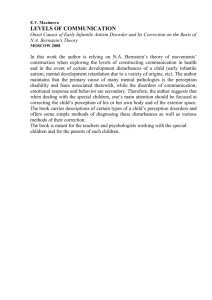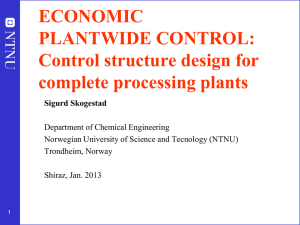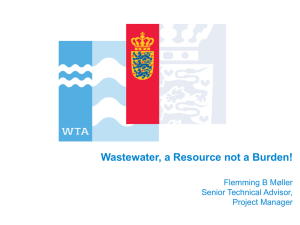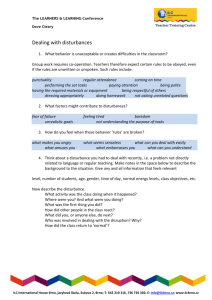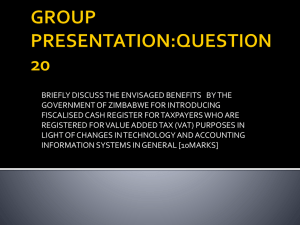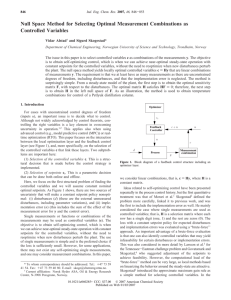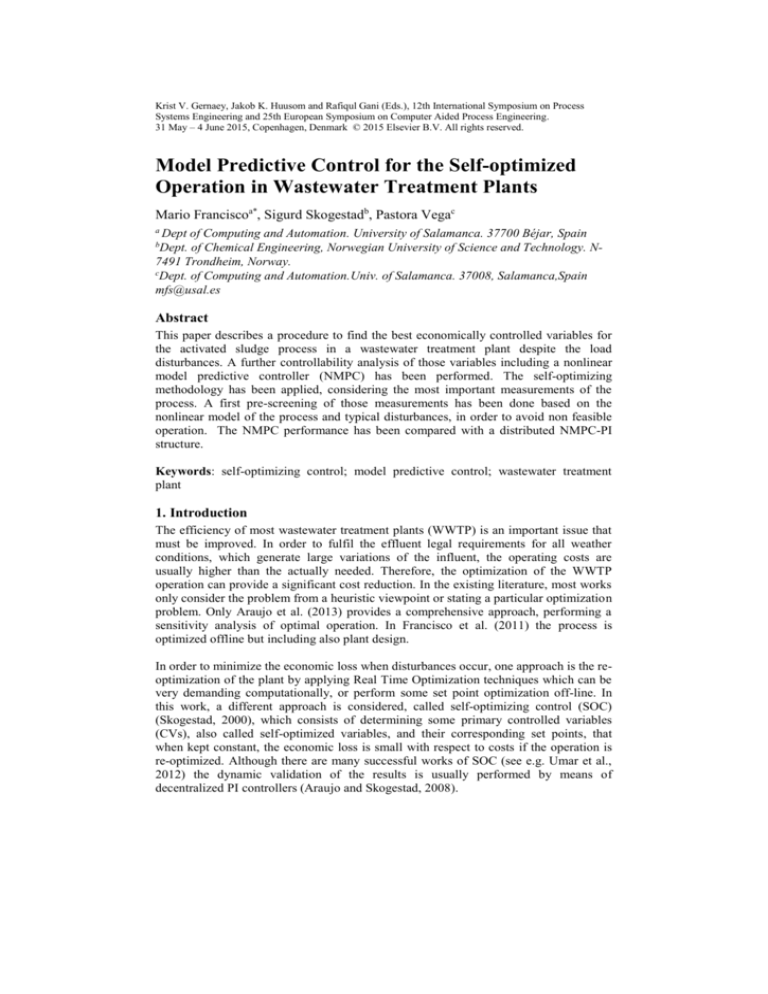
Krist V. Gernaey, Jakob K. Huusom and Rafiqul Gani (Eds.), 12th International Symposium on Process
Systems Engineering and 25th European Symposium on Computer Aided Process Engineering.
31 May – 4 June 2015, Copenhagen, Denmark © 2015 Elsevier B.V. All rights reserved.
Model Predictive Control for the Self-optimized
Operation in Wastewater Treatment Plants
Mario Franciscoa*, Sigurd Skogestadb, Pastora Vegac
a
Dept of Computing and Automation. University of Salamanca. 37700 Béjar, Spain
Dept. of Chemical Engineering, Norwegian University of Science and Technology. N7491 Trondheim, Norway.
c
Dept. of Computing and Automation.Univ. of Salamanca. 37008, Salamanca,Spain
mfs@usal.es
b
Abstract
This paper describes a procedure to find the best economically controlled variables for
the activated sludge process in a wastewater treatment plant despite the load
disturbances. A further controllability analysis of those variables including a nonlinear
model predictive controller (NMPC) has been performed. The self-optimizing
methodology has been applied, considering the most important measurements of the
process. A first pre-screening of those measurements has been done based on the
nonlinear model of the process and typical disturbances, in order to avoid non feasible
operation. The NMPC performance has been compared with a distributed NMPC-PI
structure.
Keywords: self-optimizing control; model predictive control; wastewater treatment
plant
1. Introduction
The efficiency of most wastewater treatment plants (WWTP) is an important issue that
must be improved. In order to fulfil the effluent legal requirements for all weather
conditions, which generate large variations of the influent, the operating costs are
usually higher than the actually needed. Therefore, the optimization of the WWTP
operation can provide a significant cost reduction. In the existing literature, most works
only consider the problem from a heuristic viewpoint or stating a particular optimization
problem. Only Araujo et al. (2013) provides a comprehensive approach, performing a
sensitivity analysis of optimal operation. In Francisco et al. (2011) the process is
optimized offline but including also plant design.
In order to minimize the economic loss when disturbances occur, one approach is the reoptimization of the plant by applying Real Time Optimization techniques which can be
very demanding computationally, or perform some set point optimization off-line. In
this work, a different approach is considered, called self-optimizing control (SOC)
(Skogestad, 2000), which consists of determining some primary controlled variables
(CVs), also called self-optimized variables, and their corresponding set points, that
when kept constant, the economic loss is small with respect to costs if the operation is
re-optimized. Although there are many successful works of SOC (see e.g. Umar et al.,
2012) the dynamic validation of the results is usually performed by means of
decentralized PI controllers (Araujo and Skogestad, 2008).
2
M. Francisco et al.
The first objective of this work is to find the self-optimized variables in a WWTP as a
combination of measurements, and the second objective is to evaluate the dynamic
behavior of those variables by implementing two control structures: a centralized
nonlinear multivariable model predictive controller (NMPC) and a distributed control
structure with an NMPC and local PI controllers. The methodology explained has been
applied to the activated sludge process using the Benchmark Simulation Model No. 1
(BSM1) (Alex et al., 2008).
2. Local methods for self-optimizing control
The controlled variables selection, particularly for SOC, is a fundamental issue within
the plant-wide design. The first step of the methodology is the determination of the
optimal operation, assuming here that the economics of the plant are primarily
determined by steady state behavior. The following problem is solved, considering
nominal disturbances:
min J 0 x, u0 , d
(1)
u0
subject to:
g1 x, u0 , d 0 ; g2 x, u0 , d 0
where x is the state vector, u0 is the manipulated variables vector (degrees of freedom),
d is the disturbances vector, g1 is a vector function representing the process model
equations and g2 the process constraints. The active constraints found when solving
problem (1) must be controlled tightly for optimal operation (active constraints control),
and in this work it is assumed that the set of active constraints does not change for all
typical disturbances.
Then, the identification of as many economic controlled variables as the number of
remaining degrees of freedom is performed, by using the SOC methodology explained
below. The selection is based on the Taylor expansion of the loss function around the
equilibrium nominal point uopt(d):
L u, d J c u, d J opt uopt (d), d
T
1
u uopt (d) J uu u uopt (d)
2
(2)
where Jc is the cost value when the set point is kept constant, and Jopt is the optimum
cost re-optimizing for the corresponding d, uopt is the optimum value for u and Juu is the
Hessian of the cost function.
In order to achieve near-optimal operation without the need to re-optimize the process
when disturbances occur, the loss must be minimized. Although CV can be selected as a
subset of the available measurements, lower loss is achieved by selecting CV as linear
combinations of measurements. For that reason, a combination matrix H with real
coefficients is defined as c H y , where c is the vector of controlled variables and y
is the vector of available independent measurements, that can include manipulated
variables (e.g. flow rate measurements) or measured disturbances. The matrix H can be
found through minimization of the following expression (Halvorsen et al., 2003; Alstad
et al., 2009):
Model Predictive Control for the Self-optimized operation of WWTP
min J1/uu2 HG y HY
3
1
H
where Y FWd
(3)
F
1
We ; F G dy G y J uu
J ud ; y G y u G dy d , Wd and We are scaling
y
y
matrices for disturbances and implementation errors, G and G d are the process
transfer matrices (linearized model) , and Juu, Jud are the hessians.
For problem (3), explicit solutions have been developed, where Q is any nonsingular
matrix of nc x nc (nc = No. of controlled variables) (Yelchuru and Skogestad, 2011)
HT YYT G y Q
1
(4)
3. Methodology applied to the BSM1
3.1. Description of the process
The benchmark simulation model nº 1 (BSM1) (Alex et al., 2008) has been used as a
standard activated sludge process model in a WWTP for performance assessment of
control strategies and optimization. It consists of five biological reactors connected in
series and one secondary settler. The reactors are modeled according to mass balances
described in the Activated Sludge Model nº 1 (ASM1), developed by the IWAQ
(International Association on Water Quality). An internal recycle (Qa) from the last tank
to the first one is used to supply the denitrification step with nitrate. In order to maintain
the microbiological population, sludge from the settler is recirculated into the reactors
by means of an external recycle (Qr), and sludge excess is purged from the bottom of
the settler (Qw). Note that in this benchmark no pH control is considered. More details
are given in Alex et al. (2008).
3.2. Operational objectives and constraints
The operational objectives of the WWTP include operational costs and other process
and regulations constraints. The cost defined in Alex et al. (2008) has been considered:
J kE AE PE ME kD SP
(5)
where PE is the pumping energy, AE is the aeration energy, ME is the mixing energy,
SP is the sludge production, and kE, kD are the weights representing prices. The
constraints needed for process operability are listed in table 1, where CODe is the
chemical oxygen demand, BOD5,e is the 5 day biological oxygen demand, TSSe is the
total suspended solids concentration, and TNe is the total nitrogen concentration, all
measured in the effluent.
For the BSM1 there are eight manipulated variables that correspond to eight degrees of
freedom (u): Qa, Qr, Qw, KLa(1-5). The disturbances selected are some of the most
important inputs to the plant: Q(in), COD(in), TSS(in). TN(in) is not considered in the
methodology in order to simplify the results, but it is inclusion is straightforward. The
weather profile events specified in the BSM1 derive the following disturbance vectors:
d0 corresponds to the nominal load conditions, d1 are the average load values during the
rainy weather, d2 are the average values only for a rain event (extracted from the rain
BSM1 disturbances), d3 are the average during the whole period for storms, d42 are the
4
M. Francisco et al.
average values during a storm, d5 are the average values for one year with average
temperature.
Table 1: Process constraints
Effluent constraints and constraints on manipulated variables
CODe 100 (gCOD/m3)
TSSe 30 (gSS/m3)
Qw 1844.6 (m3/d)
BOD5,e 10 (gBOD/m3)
SNH e 4 (gN/m3)
Qa 92230 (m3/d)
TNe 18 (gN/m3)
0 KLa15 360 (1/d)
Qr 36892 (m3/d)
The nominal optimal operating point has been obtained solving problem (1) for the
WWTP, considering cost function (5) and constraints of table 1. This optimization has
also been performed for different disturbances, always showing the same three active
constraints Qa (m3/d)=0, SNH_e (g/m3)=4, TSSe (g/m3)=30. Two of them are output active
constraints, so they will be linked to two degrees of freedom, remaining 5 available
degrees of freedom.
For the selection of the five self-optimized variables, the Eq. (4) with matrix Q selected
as the identity has been considered to obtain the corresponding matrix H. The initial set
of measurements selected has been taken out of Alex et al. (2008), adding also the
inputs and disturbances as measurements. In this work, a previous selection of
measurements has been performed, very useful to avoid infeasibilities for the CV
variables selected later (Larsson et al., 2001). The economic losses have been calculated
with Eq. (2) for different weather conditions using the nonlinear model of the process,
considering individual measurements. The primary CV candidate variables that make
the process infeasible for some load disturbances have been removed, which are in this
case S NH for all reactors. Then, based on this study, several sets of measurements have
been considered, giving different combination matrices H. In order to select the most
suitable, as SOC procedure is local, nonlinear losses have been obtained for each set
(Table 2) and only H3 gives feasible solutions for all disturbances.
(1)
( 5)
Set 1 (H1): SO(1) , S NO
, SO( 5) , S NO
, Q( in ) , COD( in ) , TSS ( in ) , K L a( 5) , Qr
(1)
( 5)
Set 2 (H2): SO(1) , ..., SO( 5) , S NO
, ..., S NO
, Q( in ) , COD( in ) , TSS ( in ) , MLSS , K L a( 5) , Qr
(1)
( 5)
Set 3 (H3): SO(1) , ..., SO( 5) , S NO
, ..., S NO
, Q( in ) , COD( in ) , TSS ( in ) , K L a ( 5) , Qr
Table 2: Nonlinear losses for different combination matrices and disturbances
d1
d2
d3
d42
d43
d5
H1
Infeas
Infeas
Infeas
Infeas
Infeas
Infeas
H2
0.223
Infeas
0.127
Infeas
Infeas
1.229
H3
0.038
0.627
0.069
1.182
0.821
0.300
4. Process controllability analysis
In this section, the dynamic behavior of the selected CV as combination of
measurements defined by H3 is evaluated. This study is important in order to validate
Model Predictive Control for the Self-optimized operation of WWTP
5
the possible implementation of a controller which keeps the selected CV at optimal set
points in spite of influent disturbances. The first control structure considered is a
centralized multivariable nonlinear constrained MPC for controlling the active
constraints and the self-optimized variables, with the full BSM1 as internal prediction
model, and the following objective function:
V (k )
Hp
i Hw
y (k i | k ) r(k i | k )
2
Q
H c 1
u(k i | k )
i 0
2
R
y (k H p | k ) r(k H p | k )
where y are the controlled outputs, u the manipulated variables and r the reference, k
denotes the current sampling point, y (k i | k ) is the predicted output at time k+i,
depending of measurements up to time k, u are the changes in the manipulated
variables, Hc is the control horizon, Hw and Hp are the initial and final prediction
horizons respectively, R and Q are positive definite constant matrices, and P is the
terminal weight. A second control structure with two PI controllers for the active
constraints and the NMPC to control the self-optimized variables has been considered.
This control structure has the advantage that if the MPC fails, the PI controllers still
keep set points for the active constraints. For selecting a good pairing for the PIs, the
RGA matrix has been studied; TSSe is controlled with Qw and SNH,e is controlled with
KLa(5).
Figure 1: Control performance comparison of NMPC-PI control structure (solid line) and
centralized NMPC (dashed line) for rain event disturbance (d2) at t=0. Active constraints control
(top left), self-optimized variables (top right) and manipulated variables (bottom).
2
P
6
M. Francisco et al.
In Fig. 1 the dynamic responses are presented, comparing the performance of the
control structures when a d2 step disturbance is applied. They show a good set point
tracking both for active constraints and selfoptimized variables, with reasonable control
actions. The selfoptimized variable c1 is not presented because its significance in costs
is negligible. The tuning of the NMPC has been performed by trial and error procedure,
choosing Q = diag(0.1 1 0.001 2 2 2 2) and R = diag(0.1 0.014 0.014 0.014 0.014 0.014
0.005) for the centralized NMPC; and Q = diag(0.001 2 2 2 2), R = diag(0.05 0.01 0.01
0.01 0.01) for the distributed NMPC-PI control. The horizons for both control structures
are H w 1 , H p 20 and H c 1 .The tuning parameters for the PI control No.1 are Kp=
-54.8,Ti= -27.4 and Kp= -12,Ti= -0.2 for No. 2, the first one selected by SIMC guidelines
(Skogestad, 2003). For simplicity in the comparative dynamic analysis, the manipulated
variables have not been considered in the linear combinations determined by H3.
5. Conclusions
In this work, the SOC methodology has been applied to find the optimum controlled
variables as a combination of measurements in a WWTP. A previous prescreening of
measurements to avoid unfeasibilites for large load disturbances has been performed.
The dynamic controllability of these variables has also been studied, by implementing
two control structures. The results show that both control structures give good set point
tracking, despite of a long transient due to the slow process dynamics, particularly for
the most severe disturbances. The distributed MPC-PI control shows better transient,
particularly for large disturbances, because of the separate treatment of the different
time scales of the process and the easier tuning compared to the centralized NMPC.
References
J. Alex, L. Benedetti, J. Copp, K. Gernaey, U. Jeppsson, I. Nopens, M. Pons, L. Rieger, C.
Rosen, J. Steyer, P. Vanrolleghem, S. Winkler, 2008, Benchmark Simulation Model no. 1
(BSM1), IWA Taskgroup on benchmarking of control strategies for WWTPs. Dpt. of Industrial
Electrical Engineering and Automation, Lund University. Cod.: LUTEDX-TEIE 7229. 1-62.
V. Alstad, S. Skogestad, E.S. Hori., 2009, Optimal measurement combinations as controlled
variables, Journal of Process Control, 19, 138-148.
A. Araujo, S. Skogestad, 2008, Control structure design for the ammonia synthesis process,
Computers and Chemical Engineering, 32, 2920-2932.
A. Araujo, S. Gallani, M. Mulas, S. Skogestad, 2013, Sensitivity Analysis of Optimal Operation
of an Activated Sludge Process Model for Economic Controlled Variable Selection, Ind. Eng.
Chem. Res., 52 (29), 9908-9921.
M. Francisco, P. Vega, H. Álvarez, 2011, Robust Integrated Design of Processes with terminal
penalty model predictive controllers, Chemical Engineering Research and Design, 89, 1011-1024.
I. J. Halvorsen, S. Skogestad, J. C. Morud, V. Alstad, 2003, Optimal Selection of Controlled
Variables. Ind. Eng. Chem. Res., 42, 3273-3284.
T. Larsson, K. Hestetun, E. Hovland, S.Skogestad, 2001, Self-Optimizing Control of a LargeScale Plant: The Tennessee Eastman Process, Ind. Eng. Chem. Res., 40, 4889-4901.
S. Skogestad, 2000, Plantwide control: The search for the self-optimizing control structure, J. of
Process Control, 10, 487-507.
S. Skogestad, 2003, Simple analytic rules for model reduction and PID controller tuning, Journal
of Process Control, 13, 291–309.
L. M. Umar, W. Hu, Y. Cao, V. Kariwala, 2012, Selection of Controlled Variables using selfoptimizing Control Method: Recent Developments and Applications (eds G. P. Rangaiah and V.
Kariwala), John Wiley & Sons, Ltd, Chichester, UK.
R. Yelchuru, S. Skogestad, 2011, Optimal Controlled Variable Selection with structural
constraints using MIQP formulations, 18th IFAC World Congress (Milano, Italy).

